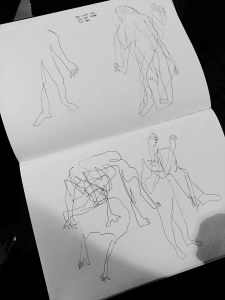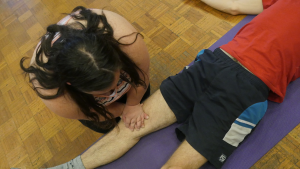Say What You Do/Do What you Say
(exercises learned from Jess Curtis)
- Describe the movement your body does. (Out loud if speech is your means of communicating. Use your mother tongue)
- Travel across the space. No movement is without description. Minimize your movement as necessary.
- Explore range/scale of language – from micro to macro. Detail to immense
I stand/I stand on my feet/ I stand on the floor/ I stand on a wooden floor/ I stand in the Town Hall/ I stand in Freemantle/ I stand in Western Australia/ I stand in Australia/ I stand on the Earth…..all are valid interpretations of the same act.
I lift my foot/I step forward/ I walk…
Say what you sense/Sense what you say
- I feel air on the palm of my hands
- I feel my t-shirt against my back
- I hear a police car passing
- I feel the light on my eyelids…
- I smell the wooden floor…
- I feel my ankle bone grind against the floor
- I feel Amy’s skin against my arm…etc
Breathe what you do/Do what you breathe
Every movement has the sound of breath, every breath has movement
Play with rhythm, expanding movement right to ends of breath
Sound What you Do/Do What You Sound
Remember all the sounds you can make with your voice and mouth (eg consonants, lips, etc). Creating a strange soundtrack to your movment, but with more freedom and play than Say what you do.
This exercise was my favourite thing I did today. I have done something similar before and actually hated it, but today I loved it. Swapping between 3 different things describing your movement, moving with the breath or moving with sound. After some exploration we were set to work in pairs. Philip and I worked together, having only met yesterday and not yet really having done anything together or even a conversation over lunch. Yet it was the most connected duo.
There was clarity of movement. It was impulsive. It was easy to listen to each other (because we were listening to both movement and sound). There was clear communication between us (by simply talking/making sounds as we danced).
Especially today I have really appreciated not only getting to work with the inspiration that is Claire, but also all the other participants in the workshop. Getting to know them, watching them, and learning about their projects and practices has been amazing and given me so much to think about.
I’m loving how safe the space is. Everyone is so open and receptive and I think that contributes to the atmosphere.
In my last journal I talked about three key words that Claire wanted to explore this week.
Connection. Time. Space
Today I really focused in on the idea of time…
Taking time to watch others be creative.
Taking time to make sure Tina understood the activities.
Taking time to make sure I was in a vulnerable place (but also safe) to complete the activity to its full capacity.
Taking time to feel every movement, to hear sounds and observe my surroundings.
Taking time to know how far I can be pushed (mentally and physically) and maybe how some of my limitations are in my head (re: ‘that’s enough’ activity).
Taking time to be creatively refreshed, recharged and empowered in my current works.
Today I made some movements with breathing and sounds.
It was bit weird but I enjoying it.
It was fun to be part of it and pressure point it was amazing. I was matched up with William. I feel connected to this person.
I was working with Lorcan with moving and sounds and I had fun with him. I really liked doing the movements.
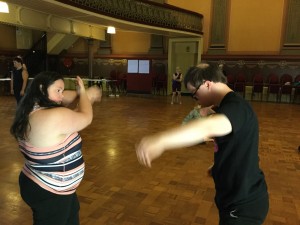
Day Two: That’s Enough
That’s Enough (from Jess Curtis)
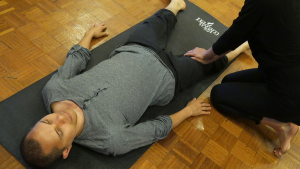
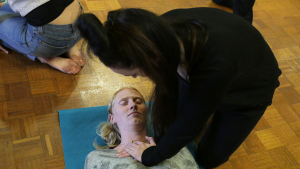
One partner lies on floor, the second partner applies weight to a single point of contact.. dropping weight vertically into the other body not pushing into it. Apply weight incredibly slowly, until the person on floor says “that’s enough” – when they can tolerate that weight but don’t want more. Learn to say it before it is too late. Avoid using hard language like “stop” that creates tension or fear of having done something wrong.
Intentions: to learn about another body, how it works, what weight it can take. What your projections are of that body (based on your assumptions or your associations in your own body). This is particularly important when working with non-normative bodies. To learn to take responsibility for your own body. To communicate with other dancers. To trust. To learn that we can talk to the people we work with, especially in dance.
Contact Improvisation intentions: To learn how to control giving weight. To learn how to give weight at a speed that the other person has time to read it, to stop it or adjust to it. To learn how to use your and the other persons skeleton to transfer weight through the bodies into the floor. To learn how your body is affected by weight being applied. Where it can/can’t take weight.


